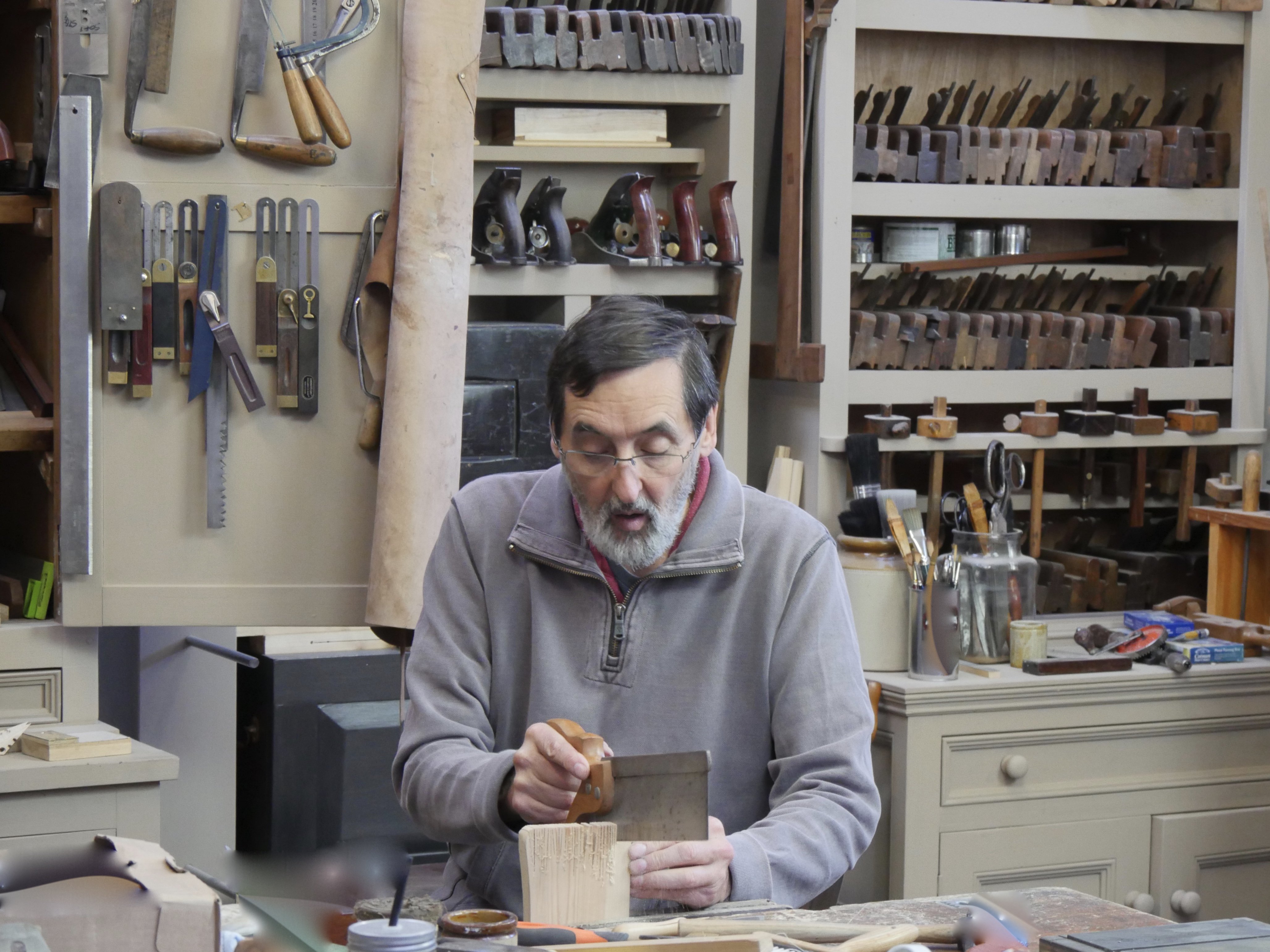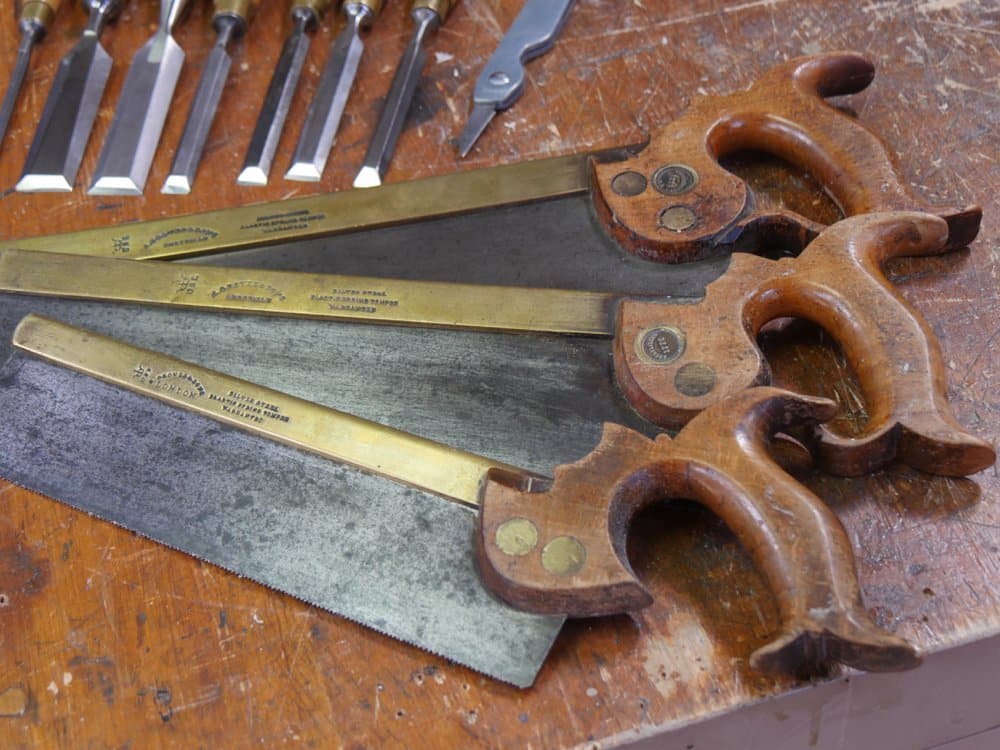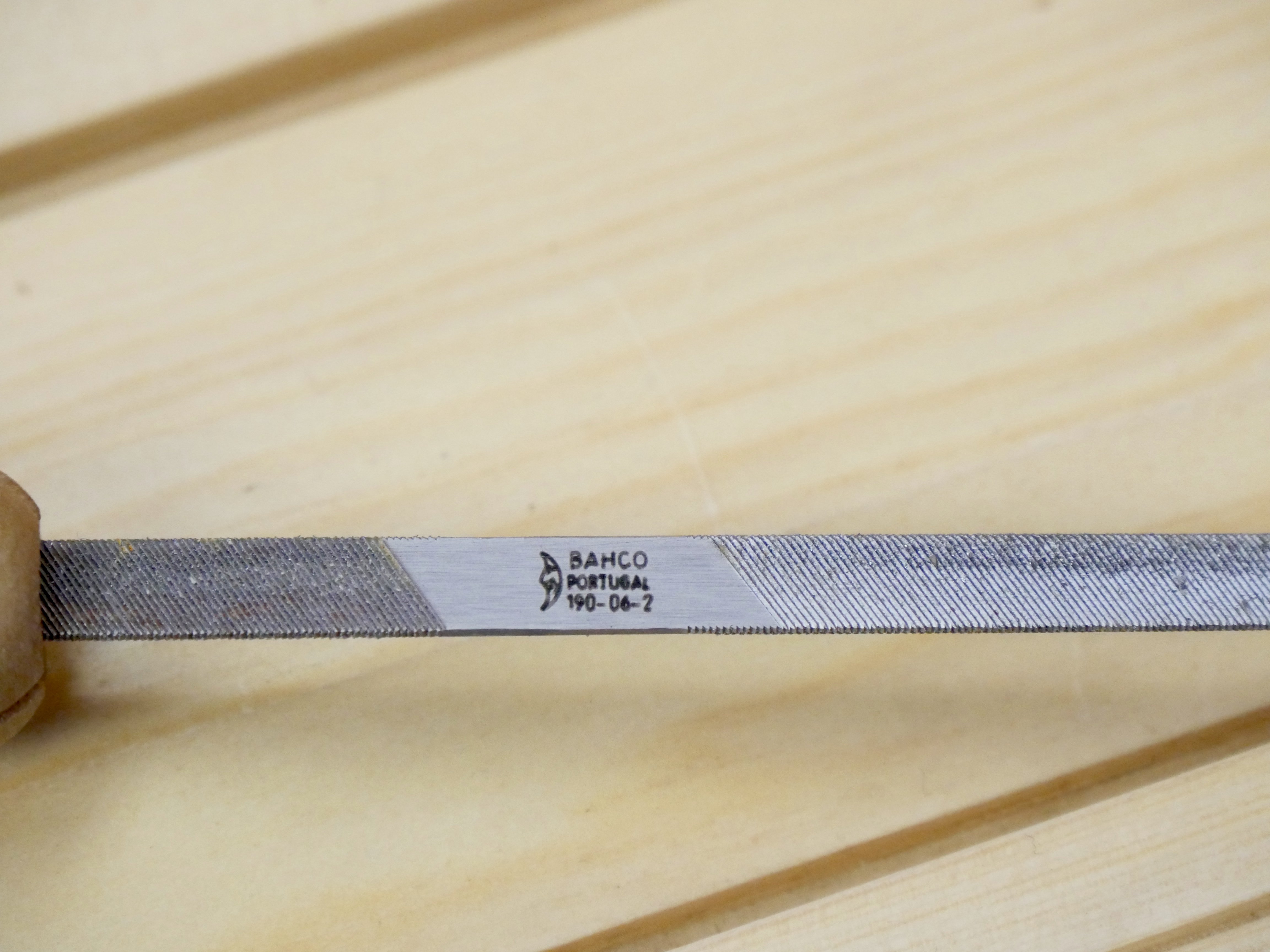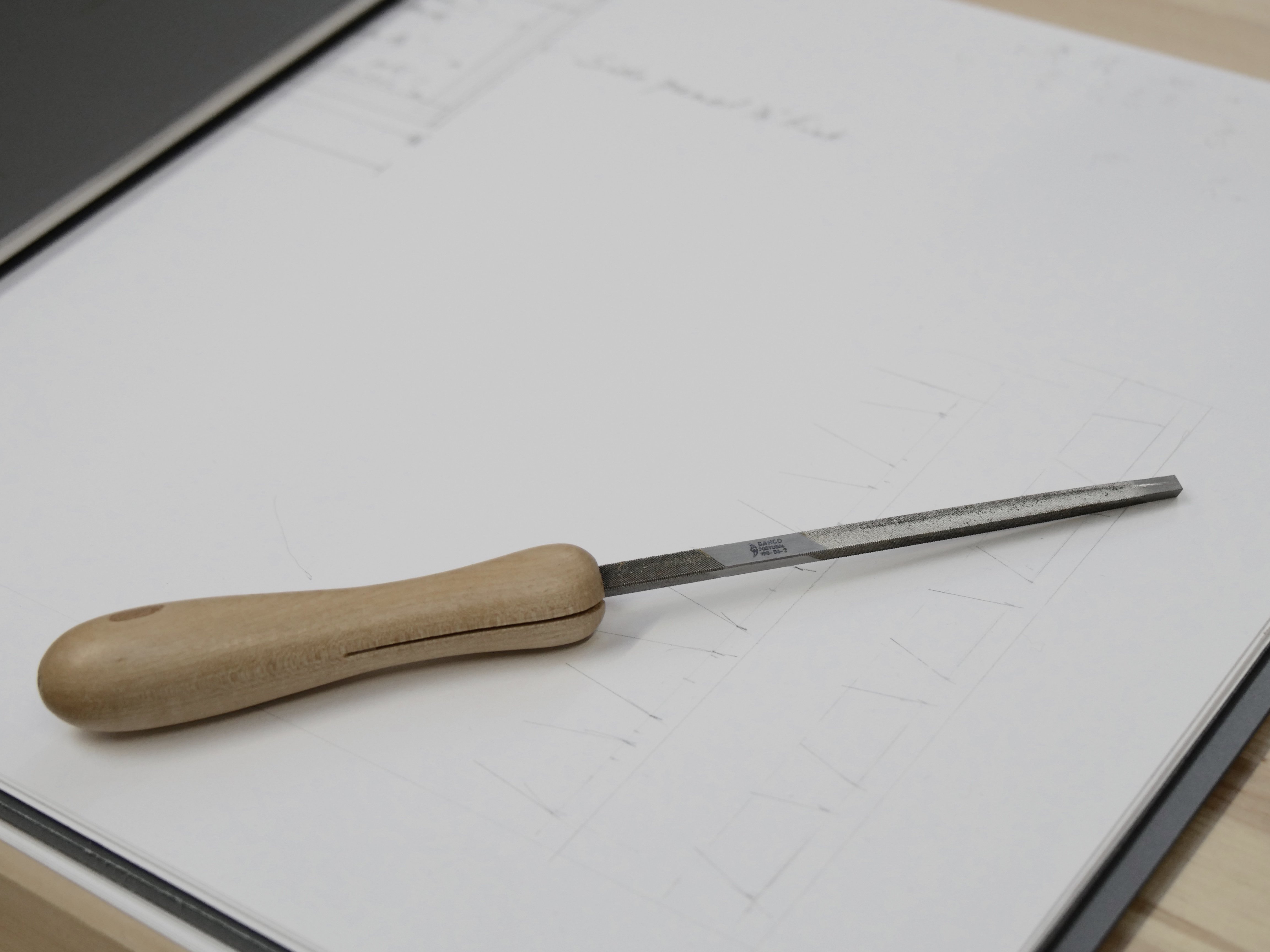Bahco Saw Files Beat the Best of the Rest in Real Bench-testing
For more information on Saw Files, see our beginner site Common Woodworking.

The number of of saws sharpened were fourteen at 14″ and twenty-six at 10″; thats 720 teeth and 428″ of saw length. With breaks it took me about 3 1/2 hours. Just look at the file above and you can see the quality of the file teeth even after 40 saws. I mean you can’t do that with any other saw file as far as I know. Fraid you can’t do even one of the modern-day Japanese saws anymore, sharpen them I mean, because 98% of today’s Japanese saw production has been strategised to create consumerist throwaway products that can no longer be sharpened. Whereas this is a shameful practice, demand is what pays the bills. I don’t use them because I won’t ever buy into something that becomes throwaway, especially as I want to keep progressing my work in weaning woodworkers away from such methodology to reestablish skilled sharpening methods in all spheres of hand work including sharpening handsaws of every kind.
The Bahco saw file has proven itself time and time again over the decades as the single most superior saw file on the market. I still have yet to find a Nicholson saw file that will sharpen one full saw length as yet but I hope that they they will one day see their flawed business model of import cheap, sell high and depend on your daddy’s reputation. Bahco is running the socks off of them right now in that the file I was using was still going after 40 saws and it looks like I will get 50 sharpenings from one end. That means that this saw file will indeed sharpen 100 saws. More than I ever achieved with any other maker. Oh, and before anyone runs away with the idea that my saws are soft, I sharpened 20 different makes including vintage saws from most eras. In the mix were S&Js, Veritas, Thomas Flynn makes and then Disstons and many more. I was amazed that this little gem just kept on going. AT the end if the day that came out a 7 pence per sharpening. These are 1960’s prices folks! I have never known any other maker perform like this in my 5 decades sharpening saws.
Surely the tide of disposability could be turned if companies could perform like this across the board. Find yourself a Bahco supplier my friends. I bought this one on Amazon via Prime and free next-day delivery for £6.40. I have found them at £5.20 so shop around a little.
Tomorrow we will ask if you buy from Stanley because you think it’s England’s finest maker or because the price is right or because you think their product carries the quality of its forebears. More shocks ahead.




Thanks for the recommendation–I have been unsure about the saw file I have been using. Just purchased a Bahco like you suggested for $8.50 on Amazon. Now I’m confident that I wont’ have to worry about the condition of my file for quite some time. It’s nice to have an endorsement I can trust (for something so reasonably priced).
Always love it when you do these product tests. It saves the rest of us the agony of poor decisions.
Unfortunately, when we go on Amazon in the USA, we get quoted $23 USD with ” free shipping” from the U.K.
Too bad. Any file that will perform well with 13-20 PPI must be a heck of file.
Someone else commented from US said they paid $8.50on Amazon.
Right–here was the one I saw: https://www.amazon.com/Bahco-4-183-06-2-0-Taper-File-6-Inch/dp/B0001P0O9Q/ref=sr_1_1?ie=UTF8&qid=1477655223&sr=8-1&keywords=bahco+saw+file
If you search Amazon US for Bahco saw file you can find them in the $8 range, the model number on your file is for the U.K. https://www.amazon.com/Bahco-4-183-06-2-0-Taper-File-6-Inch/dp/B0001P0O9Q/ref=sr_1_1?ie=UTF8&qid=1477668859&sr=8-1&keywords=Bahco+saw+file
Lee Valley carries Bahco — in Canada, they are $7-$12, depending on the file, so I’d imagine somewhat less in the States.
Hi there from Portugal,
I also use some Bacho files to sharp my 2nd hand saws, I got from ebay, and yes I learn to sharp them from your videos, Thank you for teach me a great skill.
Thank You Master Paul Sellers.
Hi, Paul and team.
I live in Portugal, 30 Km from the factory that produces the Bahco files.
In Portugal there is also another very good files company, Tomé Feteira, that you have already spoken about.
I’m not a professional, so I don’t sharpen as much as necessary to compare between both brands and get conclusions like yours.
What is your oppinion between both? Is one better than the other, or are they at the same level?
Thank you for everything, I learn very much from you.
Portugal Rules 😀
Nice one! Has anyone here, and/or Paul, used Bahco’s engineering files? Based on this I am imagining similar quality and performance.
I’m not entirely sure what you mean by engineering files, but I have used several of their various flat files and they are great. I like the oberg cut ones especially, fast material removal and good finish at the same time.
I believe Britain refers to engineers what we call machinists in the USA.
Thanks for the feedback, looks like I’ll be getting some then.
Yes, engineering/machinist files- same thing. Thanks.
Hi James i use a single cut (bastard file) bahco file for most of my woodworking tools ie card scrapers ,flattening the tops of saw teeth ,draw knife sharpening to mention just a few i am so grateful to Paul for showing us these hints n tips and saving us a lot of money ,not having to buy the not so good tools is something i’m so thankful for
I’ve read it is possible also to resharpen files in acid bath. Probably you could go even farther with it.
Recently I saw what was called a file sharpening with a copper scraper made out of the flattened end of a piece of ½ inch copper water pipe, brushed with a wire brush and/or card file, bathed in an acid bath, then naturalized the acid on the file with baking soda.
While he calls it “sharpening the file” to me it seems that what is being done is the cutting points are being cleaned.
Amazon is now sold out of Bahco X-Slim Taper Files.
LOL. That didn’t take long 😉
I’ve always used them in all sizes. The reason I got them first for saw sharpening was because they were the cheapest saw files I found “go figure” as the yanks would say. As always thanks very much Paul and team
How do you choose which BAHCO saw file to buy? Confusing.
It’s all about the size really, 5or6 inch saw files will work well for anything from 20tpi down the about 7 tpi. I’ve only used the large saw for my 4 tpi and I only use that saw for 3 to four inch hardwoods. I prefer getting the yard to rip it down for me
I finally found a good local supply of Bahco here in Australia but unfortunately they are right now going out of business. Masters is closing down, they have up to 60%-70% off this weekend so if your reading this in Aus hurry into your local Masters and stock up on Bahco. Unfortunately Bunnings (the bigger surviving hardware chain here) don’t stock Bahco, last time I checked they only had the Nicholson rubbish. But if you have a look at the Nicholson 4inch flat you might still find a good one, for some reason the packet had Made in USA, even though I just checked then and it has Mexico stamped in the file. I’m not sure why but this little 4 inch is much better than the other larger Nicholson’s, perhaps I was just lucky and got some old stock. My older 4inch Nicholson warding bastard has Australia stamped in, this file has lasted me for over 20 years now and is still usable!
If you’re looking for a source of the Bahco file in Paul’s article the part number is shown in one of his photos (P/No 190-06-2). Just found a company online KL Tools (UK based) that will supply and deliver the file to Aus for AUD$15.00
Thanks again Paul
I always read your blog and especially the tests with great interest.
I have used Bacho files and other of their tools like wrenches etc. for quite a while, and they are great and easy to get here in DK.
Are you using other sawfiles from Bacho and if you are, would you please write me the product numbers?
Thanks to mr. Sellers I was keeping eye on it and bought it when it was on sale. I payed € 3.99 in amazon.it.
I can’t completely agree with your assuption that Japanese saws are just throwaway, sugesting being wasteful. As with upcycled timber, used saw blades can be put in the recycling bin too.
Sorry John, can’t really agree back either. I think you perhaps miss the point (pun intended). Recycling is still really a retrograde step that forces people to discard what could actually be used for decades if the teeth were simply hardened steel rather than impulse hardened. We are not talking glass jam-jar- or a tin-can-type recycling here, as perhaps your response suggests, but creating a non-sustainable replacement tool requiring purchasers to always go back to the maker; an absolute intended consumerist ploy. In no way is this the same as upcycling or even recycling timber, taking the material to make another useful wooden product from. The steel plate may have some use for something very limited somewhere but I can hardly think what beyond perhaps a card scraper or something.
Is a file a “replacement tool requiring purchasers to always go back to the maker; an absolute intended consumerist ploy”?
Modern Japanese saw blades use a tiny amount of steel, last for ages and are well suited to a wide range of applications including both solid timber and synthetic materials.
It’s great to sharpen your own saws but the benefit to the environment of using a file to sharpen a saw vs an impulse hardened or the risk of being enslaved to a tool company are 0%
I’m surprised at this question when the difference between a file and saw is so significant. They key here of course is that the file by nature has to be of maximum hardness to file hardened steel. The tool (file) is developed solely for filing hard steel and not for sawing wood. It cannot be less hard than sufficient to sharpen the saw teeth. If you meant a Nicholson file that will only sharpen one saw then the file is created as a a consumerist ploy, yes. With Bahco files that’s not the case if they sharpen say a hundred saws which I have known them to do. Japanese saws don’t “use a tiny amount of steel” they just use steel as do other saws western, or Asian. In my view there is whole ideology surrounding Japanese saws that people have bought into over the past three decades based mostly on the fact that people, woodworkers, and especially professional woodworkers, can no longer sharpen their saws and in fact most Japanese craftsmen can’t and don’t sharpen their saws any longer because they too now buy their own manufactured throwaways too. It’s very freeing to own saws that are already 100 years old and still have about 100 years life in them. This is a wonderful thing to me and thousands of others so we share it so people can choose an alternative. It’s also very freeing to simply sharpen your own saw and of course the modern-day pull strokes are unsharpenable. Such a sad and sorry condition for humankind.
“Is a file a “replacement tool requiring purchasers to always go back to the maker; an absolute intended consumerist ploy”?”
A file is a tool which wears out. Just like your impulse-hardened saw.
“Modern Japanese saw blades use a tiny amount of steel, last for ages and are well suited to a wide range of applications including both solid timber and synthetic materials.”
They don’t use much less steel than an equivalent western saw, and they don’t last one tenth as long as a similarly sized saw I can sharpen multiple times. And western saws cut synthetic materials just fine. They do tend to dull faster than when cutting solid wood, but since I can sharpen them back up in a few minutes, I don’t worry about it too much.
“It’s great to sharpen your own saws but the benefit to the environment of using a file to sharpen a saw vs an impulse hardened or the risk of being enslaved to a tool company are 0%”
Really? I can, right now, buy a box of saw files which will last me a decade or more for roughly the cost of two cheap impulse-hardened saws. With that box and the three saws I typically use (I paid under $100 for all three combined) I can avoid buying several hundred dollars worth of impulse-hardened saws which will be thrown away over many, many years. Are you really trying to argue that there are no benefits to that?
I get it. You don’t want to learn to sharpen saws. You like your impulse-hardened throwaways. That’s fine. To each his own. But please quit trying to pretend that there are no benefits to my way of doing things. After all, if there was no benefit, I wouldn’t be doing it.
I like the fact that you can come across a bunch of old tools at a garage /junk sale and with the knowledge gleaned from Paul and others like him put them back into serviceability , quite often better then when first produced. A No 3 , 4 1/2, sash saw and trammels for $20 , repairable and able to be used for an outlay of about another $20 in consumables with some elbow grease. How many have used these and how many more once repaired? I don’t believe that the disposable market really compares.
I cut up a disposable Irwin and used it as cards scrapers the work quite well. I always have one throw away for plywood. I don’t like to use my good saws for ply as I find it dulls them quite quickly
Just pulled the trigger on the subject double end file on eBay, cost $11.89 US. A few days ago I sharpened a 5-1/2 tpi Disston thumbhole D8 ripcut that was in what I call “just needing a touchup”. By the time I was done I had used all faces of the brand new Nicholson to the point that I literally tossed it into the junk box. As a hobby woodworker with some tool and die training I have some files that are 30-40 years old and still have some tooth. I am done with the cheap files! Although I do have a new Bahco like the one used in the test, I have not yet used it. There is an old Spear dovetail and an old Disston tenon saw waiting for me. Thanks for posting your test results, and for the record, I own 15 old fashioned saws……and one pull saw which I only use for flush cuts.
I’ll add my thanks to you too, Paul, for doing the test and sharing your results with us.
I came to the blog too late to get the really good price from Amazon (US) but managed to get one for 18.39USD with free shipping from them.
In your test, you mentioned that you used a single end of a double-ended Bahco file to sharpen all those saws. Is it possible that the file you used is atypical of the brand? One wonders if you will get the same quality on every file. I have found a wide range of quality in modern Nicholson files (which are what are available to me locally when I need one right away).
Finally, do you plan to do more question and answer videos? I have truly enjoyed them and learned a great deal. If you plan to do more, please let us know so that we can send our questions to you.
with best regards from central Texas, USA – bh
Bob-
I have used both myself restoring my collection of vintage saws and recutting/rebuilding more modern saws in to something usable. I can’t even tell the bahco’s have been used, but every nicklson has had visible wear after the first saw pass.
Here in the US, I get Grobet from Isaac Smith. His advice is more than worth any marginal improvement in the products I buy.
Your Quote: “Bahco is running the socks off of them right now in that the file I was using was still going after 40 saws and it looks like I will get 50 sharpenings from one end.”
I can give you the origin of “knock your socks off”, Paul, but it would have to be private between us two old guys. If curious, let me know if his bench is still open. I am, at the end of the day, a student of Churchillian English.
There has been a sudden world wide shortage of that File… Had to get mine shipped in from England. Wonder what happened? 😉
The very best of saw files can suffer premature death if they are “abused” during the saw sharpening process. I use Grobet, Bacho and Tome Feteira files. Abuse can include using excessive force in trying to remove too much material in a single cut, rust and other foreign material in the saw gullet and probably many more factors. I learned good filing technique from watching Paul sharpen his saws online. Occasionally, I get too aggressive and ruin a really well made saw file. Take your time in saw sharpening and enjoy the process of watching filings flow effortlessly from the blade. Sight and sound feedback are the best indications of problem areas which may warrant adjusting your presentation.